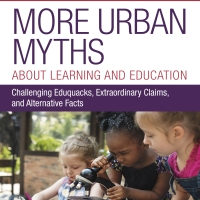
New meta-analysis on the effects of Augmented Reality in education (Best Evidence in Brief)
There is a new Best Evidence in Brief and this time I picked this study from this biweekly newsletter written up by Elaine Lau:
Augmented Reality (AR) is a technological advancement of the modern era that allows users to enjoy virtual experiences through their senses. AR has been adopted in education to enable students to visualize and experience abstract concepts in real-time real-person, leading them to a deeper understanding of the concepts than they can gain solely from reading books.In a meta-analysis of over 35 studies by Feng Li and colleagues, the authors explored the advantages and disadvantages of AR application on academic achievement in K-12 education. Applying AR technology in student learning not only enhanced students’ interest and motivation, it also improved their attention by concentrating their focus. AR provides students with an interactive, visualizable and understandable learning environment, which stimulates their senses of presence, immediacy and immersion, offering them a vivid learning resource.However, the benefits of AR can be hampered by the limitations of such an integrated method, and the shortcomings of AR system functions. Students can feel frustrated in their learning when the AR system fails; and the huge amount of information students receive through AR learning can cause cognitive overload. AR can also cause discomfort in students’ hands and eyes with its handheld mobile devices and glittered cards. Further, AR does not apply equally well in all subjects. Among the science subjects as investigated in the analysis, AR has a medium effect on earth and space science (g=0,618), physical science (g=0.63) and mathematics (g=0.407), and a minimal effect on biology (g=0.163) and language (g=0.239). This could be due to the different nature of the knowledge and concepts in different subjects, where some subjects, such as earth and space science, physics and math are more able to be presented visually and vividly through AR. Biology may involve more subtle interactive phenomena that might be difficult for AR to simulate. The minimal effect for language learning is difficult to account for, however, the sample size was too small for conclusive analysis.The authors call for proper planning and adjustment involving integrating teaching strategies and functions in the AR application in K-12 education. Educators are suggested to develop a long-term teaching design, and integrate AR implementation into existing physical teaching content. Educators should also be aware of the existing problems of AR to ensure students are using AR safely. Enough exposure to AR learning should be provided for students to ensure they adapt well to this new mode of learning in order to maximize its benefits.
This content was originally published here.


